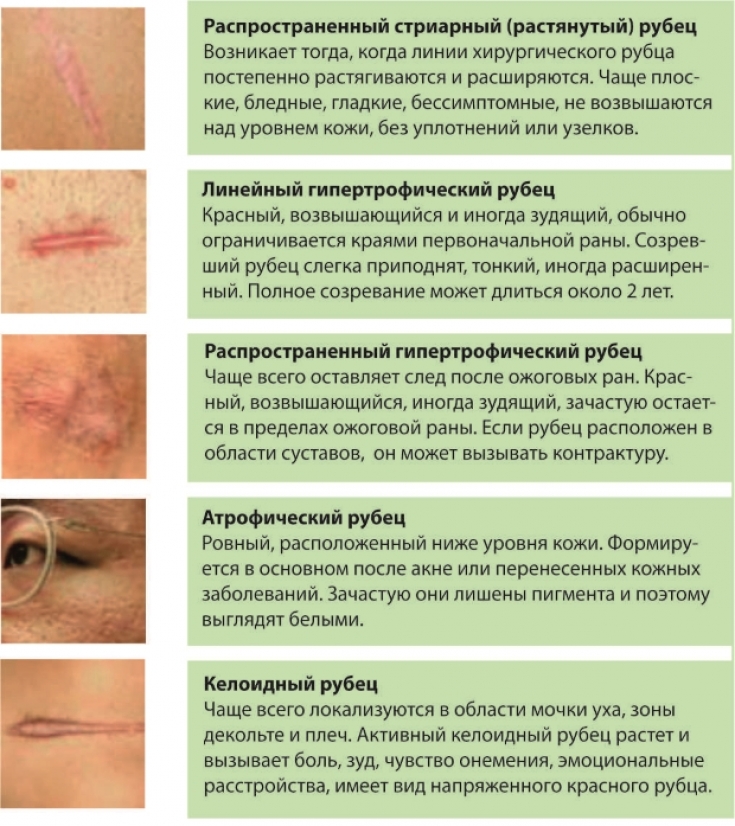Keloid scar – proliferation of connective tissue after injury. They are dark red or brownish in color and are most often localized on the neck, face, chest, back, less often on the limbs. Few people can boast of a perfect body without a single scar.
Lucky if the scar is in a less visible area, and not on the neck or face. But what about people who have a keloid scar larger than the wound itself and spoil the aesthetic appearance? Modern medicine has developed various measures to eliminate scars and scars.
The online publication estet-portal.com tells about the most popular and effective ways to get rid of them.
1. Causes of appearance and development of keloid scar
2. Methods for getting rid of a keloid scar
Causes of appearance and development of keloid scar
Everyone knows that collagen is essential for our body. But its overabundance can also have negative consequences.
Doctors have come to the conclusion that the reason for the formation of keloid scar is increased production of collagen by skin fibroblasts. In humans, the tendency to produce collagen is genetic.
People with this tendency are advised to avoid any injury to the skin. And in the case of operations or surgical interventions, you need to take care of the damaged area in order to prevent the growth of the scar.
In appearance, keloid scar is different from the usual hypertrophic scar. It can be defined as a bluish or purplish scar raised above the skin. It has clear edges and outlines.
The formation of a keloid scar takes place in 4 stages:
• epithelialization – the wound heals, a film is formed, which begins to gradually coarsen after 10-15 days;
• swelling starts from the end of the third week, when the scar begins to thicken, possibly itching and reddening;
• coarseness – the scar is covered with plaques, becomes bumpy;
• softening - at this stage the scar becomes mobile and softens.
Keloid scar – this is not an isolated case, it indicates a violation of the development of the connective tissue of the body. The dermis works excessively actively, trying to renew the damaged skin, as a result of which the all system malfunctions.
Follow us on Instagram.
For comparison: in keloid, the amount of collagen is 8 times higher than in a normal scar and 20 times higher than in normal non-hypertrophied skin.
Methods of getting rid of keloid scar
Treatment of keloid scar is carried out by therapeutic and surgical methods. The essence of therapeutic treatment is to create all conditions to minimize the visibility of the scar. During surgical treatment, the keloid scar is excised.
The choice of treatment method can only be made by a doctor, based on the age of the scar and its location.
Surgery is used as a last resort, as recurrences often occur.
If this cannot be avoided, methods to prevent overgrowth should be employed. New keloids are easier to heal than old, coarse ones. Therefore, sometimes surgical excision is performed.
But more often doctors resort to therapeutic treatment of keloid scars, which is divided into:
1) medication. Corticosteroids are injected into the keloid scar to reduce collagen production. Interferons may also be used. They act as immunomodulatory drugs. Sometimes enzymes that break down hyaluronic acid are used. Acid – firming agent keloid scar;
2) microcurrents with the help of ointments electrophoresis and phonophoresis are performed;
3) squeezing – the scar is tightened with a bandage with silicone. Only suitable for fresh keloid scars;
4) laser treatment – the laser sticks together small capillaries that feed the scar tissue. Relapses are possible, so the use of a laser is combined with hormone therapy;
5) cryotherapy – exposure to liquid nitrogen. Effective for fresh scars. Nitrogen application is carried out in short episodes, during which connective tissue cells are affected;
6) radiotherapy – the scar is irradiated with small radiation, in which fibroblasts are destroyed. It has contraindications, so it is not suitable for everyone;
7) cosmetic procedures – only suitable for fresh keloids. They affect the upper layers of the dermis with the help of procedures: peeling, dermabrasion, mesotherapy and others.
It will not be possible to eliminate the keloid scar with folk remedies. In addition, there is a risk of damaging it and causing even more proliferation of connective tissue.
Keloid scar removal – not necessary. It does not harm the owner. A keloid scar is only an aesthetic problem.
If the location of the scar is very inconvenient (in the groin or on the bends), then keloid scars are susceptible to damage and are dangerous. In these cases, scar treatment is highly recommended.
Which way to choose – It's up to you and your doctor to decide. No decisions can be made without a consultation with a dermatologist.
Carefully weigh the pros and cons of all treatments. After all, like other procedures, all methods of removing keloid scars have side effects.
How to get rid of scars at home
You might be interested in: Abs Workouts.







Add a comment